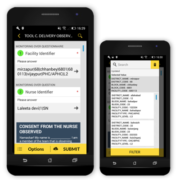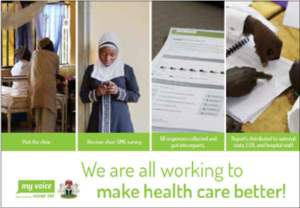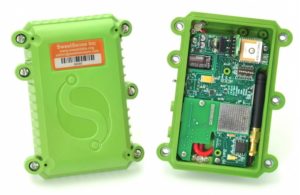Real-time Data for Real-time Decisions
“In today’s world of big data, real-time data is being used every single second to shape both important and not-so-important decision,” said Christine Garcia of SocialCops, a panelist in the fourteenth installment of the Health Communication Capacity Collaborative’s Innovation webinars focused on real-time activity monitoring and reporting.
In this webinar, a variety of technologies and platforms enabling real-time activity monitoring and reporting for more efficient program performance and improved global health were explored.
Samir Doshi, Senior Scientist at the U.S. Agency for International Development (USAID) Global Development Lab, moderated the session, describing USAID’s view of real-time data and how to use this to proactively manage programs. Samir discussed the importance of Adaptive Management, using double-loop learning to move into an agile practice enabling a more flexible, iterative approach to program design and execution.
 Christine Garcia offered an overview of Collect, part of SocialCops’ data intelligence platform designed to bring the entire decision-making process to one place. Collect, dubbed the “world’s most resilient data collection app,” enables tracking and monitoring of data in real-time by arming front-line health workers with an Android device and user-friendly app that can more in the most remote areas. Collect’s real-time monitoring capabilities offers the ability to track entities (people, places, projects and more) over time without re-entering baseline information. Collect has been used to support numerous programs across sectors. The India Health Action Trust, for example, used Collect to gather data from 1,113 rural health centers in Uttar Pradesh. Collect was used to double-monitor pregnant women’s deliveries – both the women themselves and the staff activities. This enabled the health centers to proactively monitor for problems, prevent complications and ultimately prevent maternal mortality.
Christine Garcia offered an overview of Collect, part of SocialCops’ data intelligence platform designed to bring the entire decision-making process to one place. Collect, dubbed the “world’s most resilient data collection app,” enables tracking and monitoring of data in real-time by arming front-line health workers with an Android device and user-friendly app that can more in the most remote areas. Collect’s real-time monitoring capabilities offers the ability to track entities (people, places, projects and more) over time without re-entering baseline information. Collect has been used to support numerous programs across sectors. The India Health Action Trust, for example, used Collect to gather data from 1,113 rural health centers in Uttar Pradesh. Collect was used to double-monitor pregnant women’s deliveries – both the women themselves and the staff activities. This enabled the health centers to proactively monitor for problems, prevent complications and ultimately prevent maternal mortality.
 Adam Talsma, of Reboot described an issue encountered in rural Nigeria, where primary health centers had no formal way of collecting patient feedback. Reboot designed My Voice to give patients the opportunity to provide feedback on the quality of care they received through an SMS survey. The data are stored in a database with an online web interface, designed to be accessible even in low bandwidth environments. The citizen feedback collected through My Voice proved to be capable in generating change in service provision enabling service providers to address identified challenges and allowing community leaders to advocate for service delivery improvements. This “data-for-advocacy” model of tech-enabled citizen reporting led to greater accountability within the health systems.
Adam Talsma, of Reboot described an issue encountered in rural Nigeria, where primary health centers had no formal way of collecting patient feedback. Reboot designed My Voice to give patients the opportunity to provide feedback on the quality of care they received through an SMS survey. The data are stored in a database with an online web interface, designed to be accessible even in low bandwidth environments. The citizen feedback collected through My Voice proved to be capable in generating change in service provision enabling service providers to address identified challenges and allowing community leaders to advocate for service delivery improvements. This “data-for-advocacy” model of tech-enabled citizen reporting led to greater accountability within the health systems.
 Evan Thomas, Chief Executive Officer of SWEETSense Inc., a spinoff from Portland State University’s Sustainable Water, Energy and Environmental Technologies Laboratory, recognized the need to replace reporting with continuous measures of actual impact over time. The satellite and cellular based sensors developed and installed by SWEETSense in interventions enables users to monitor performance of interventions and monitor health-related behaviors. In Rwanda, for example, sensors used in partnership with DelAgua provided quantitative and continuous operational data on the usage and performance of new water filters and cookstoves in rural villages. The data were compared against survey data, providing better approximations of quantifiable behaviors that lead to proven health impacts. Sensor data is available in real-time through an online dashboard accessible from any smartphone and requires minimal training. Additionally, the program ties performance data to payment systems through innovative funding mechanisms, such as carbon and health credits, ensuring the program’s impact is sustained beyond the initial grant period.
Evan Thomas, Chief Executive Officer of SWEETSense Inc., a spinoff from Portland State University’s Sustainable Water, Energy and Environmental Technologies Laboratory, recognized the need to replace reporting with continuous measures of actual impact over time. The satellite and cellular based sensors developed and installed by SWEETSense in interventions enables users to monitor performance of interventions and monitor health-related behaviors. In Rwanda, for example, sensors used in partnership with DelAgua provided quantitative and continuous operational data on the usage and performance of new water filters and cookstoves in rural villages. The data were compared against survey data, providing better approximations of quantifiable behaviors that lead to proven health impacts. Sensor data is available in real-time through an online dashboard accessible from any smartphone and requires minimal training. Additionally, the program ties performance data to payment systems through innovative funding mechanisms, such as carbon and health credits, ensuring the program’s impact is sustained beyond the initial grant period.
Concluding the webinar, panelists touched on implementation challenges they’ve encountered. Evan Thomas discussed the lack of compatibility between the iterative design process of new technology and the budgeting and planning process of program managers. Christine Garcia noted challenges with data quality, explaining that while sensors do provide better data quality, you can’t build one sensor that will solve all monitoring problems across all decisions that require real-time data. Data quality challenges within a data collection app, she explained, is an issue but is fixable.
Of particular note to webinar attendees was the willingness of panelists to share the trial and error experienced while designing iterations of their technologies to improve user experience. SocialCops, for example, learned to “turn questions green” when complete to improve user experience when collecting data. Evan Thomas similarly shared the extensive iteration process required for developing sensors.
A recording of this webinar, as well as PDFs of each presentation, can be found here.








Leave a Reply
Want to join the discussion?Feel free to contribute!